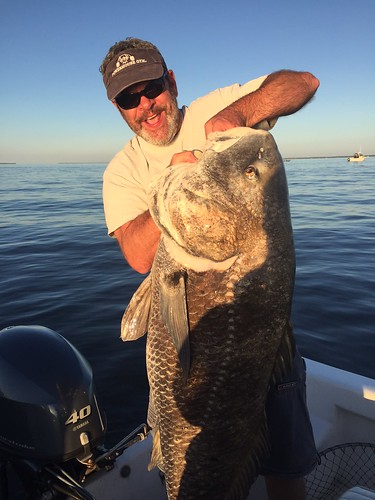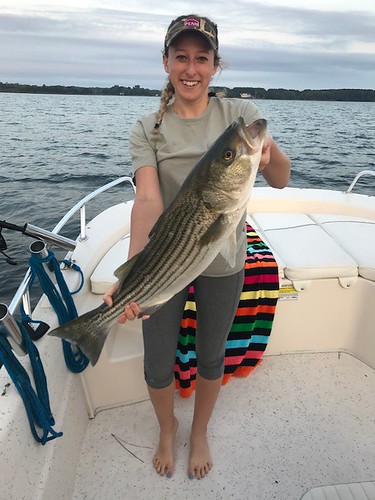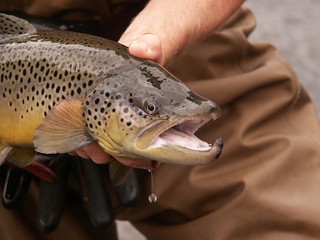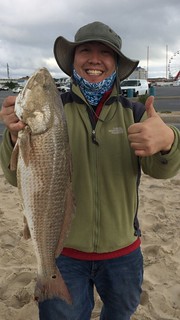Weekly Fishing Report: October 4
The recent cold evenings this week are beginning to have an effect on water temperatures in the Chesapeake Bay and tidal rivers. Bay surface water temperatures are down to about 70 degrees Fahrenheit and the tidal rivers are in the mid to upper 60s. As a result, the upper bay region striped bass fisheries are starting to see some water temperature-dependent changes in fish behavior.
Spot are still available this week at the Sandy Point area, and also the mouth of the Magothy and Chester rivers but are showing signs of being on the move so this week may be your last chance to fill a dockside pen with some live spot to take you through the next week or so for your live lining trips. If you do, make sure to wire your lid down to protect your spot from a four legged bandit — river otters are very skilled at slipping in and out of lids held down with bungee cord!
Bait will soon begin to exit the tidal rivers and it will be “game on” for jigging along steep channel edges. Jigging is already gaining momentum at Podickory and Love Point as well as various shoals, reefs and knolls out in the middle of the upper bay region. Trolling a mix of umbrella rigs, spoons and bucktails has also been productive at these same areas but will take some weight or planers to get down to where fish are suspended.
Before we get into this week’s fishing report, I wanted to remind everyone that they can submit their own fishing reports and photos to the Maryland Angler’s Log. To post a report, please email your name, hometown, photos, location information and additional content for your report. All information is optional, but encouraged. New reports are posted daily during the busy fishing seasons. You can see our most recent Angler’s Log here.
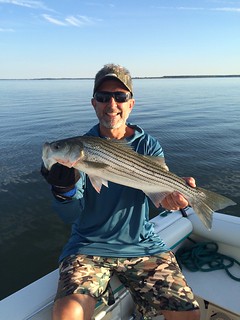
Herb Floyd holds a nice striped bass he caught near the mouth of the Choptank River. Photo submitted by Herb Floyd
White perch are starting to show signs of schooling up in the deeper parts of the region’s tidal rivers. Jigging with either a sinker and dropper flies or a small jig is a great way to catch them. Bottom rigs baited with clam snouts, shrimp, bloodworms or peeler crab is also a good way to catch a mess of fat white perch.
Water levels in the lower Susquehanna River have been a bit on the low side lately due to the power generation gates being closed for the most part for the last six days. Striped bass are being caught by those casting topwater lures in the early morning hours in the river and flats. There is a large percentage of shorts but a few nice fish are being caught. Casting and jigging soft plastic jigs has also been productive and smallmouth bass and walleye can be part of the mix at times in the river.
In the middle bay region, striped bass are being found on the channel edges of Tolley’s and Thomas points, the outside edge of Hackett’s and the False Channel. Spot are still available but showing signs of moving from one location to another. Live lining spot is still the most popular way to fish but jigging is catching up as water temperatures cool to about 70 degrees. Water temperatures in the tidal rivers are a good 5 degrees cooler so bait will start to feel the urge to exit the tidal rivers. This event will set the stage for striped bass to intercept them and start to fill out and bulk up, making for some beautiful-looking fish.
Trolling can be a good option along channel edges and umbrellas tend to be very popular behind inline weights. There are still a lot of small bluefish in the region and will take their due of twistertails and sassy shads and of course those delectable spot you’re live lining.
White perch are showing signs of gathering in deeper spots in the tidal rivers and creeks, they’ll be around for a while and this marks a good time of the year to target them. Small jigs, rigs with dropper flies and of course bottom rigs with bait are good ways to catch them.
The shallow water striped bass fishery is improving in many areas of the middle bay region. Small striped bass below 20 inches tend to be a large percentage of the catch but offer plenty of fun on topwater lures. Larger fish are finding the cooler waters in the tidal rivers much to their liking and are steadily moving in to intercept bait.
The lower bay region has a wide variety of fishing opportunities this week. Live lining spot along channel edges in the Point Lookout and lower Potomac River area has been very good. There are throwbacks but some nice legal-sized striped bass are being caught. Bluefish tend to be heavy-handed and they are considered uninvited party guests by live liners, since they destroy a large number of spot baits, which are intended for striped bass. Fortunately, plenty of live spot are still available in the region. Spot and especially the larger ones are going to be getting itchy in the next coming week and heading south into Virginia waters and toward the mouth of the bay. Fishing for large spot is still good in the lower Potomac and Patuxent rivers as well as the Tangier Sound area. Small to medium sized croaker, kingfish and sea trout will also be in the mix. White perch are being found in some of the deeper areas of the region’s tidal rivers and creeks.
Large red drum continue to be caught and released in the Middle Grounds and Target Ship areas by jigging and trolling. Smaller slot sized red drum are being caught in the Tangier Sound region along with speckled trout.
A mix of bluefish, Spanish mackerel and small striped bass are working schools of bay anchovies over in the shipping channel areas of the bay and also at the mouth of the Potomac River. Casting to the surface fish, jigging or trolling a mix of spoons, bucktails and surgical tube lures (hoses) around the outside edges are good strategies.
Before we get into the crabbing, freshwater and coastal/ocean sections of the report, here is the most recent update on bay conditions and the fishing forecast from the team at Click Before You Cast.
Weekly Bay Fishing Conditions Forecast Summary – Oct. 4 – 11
Rocktober is here! Main Bay temperatures have cooled several degrees since last week and are now down to about 2 degrees to about 71 degrees. Expect windy conditions from Wednesday through Thursday morning. Sunny, dry and warmer temperatures through Saturday and then conditions will become cooler and wetter through Wednesday.
These cooler conditions will continue to help improve water temperature and oxygen conditions and are much more to the liking of hungry rockfish. While most Maryland waters have adequate oxygen from surface to bottom, start your search just above the “Do not fish below this depth.” In the upper bay near Swan Point (along Tolchester Channel) and Baltimore Harbor avoid fishing depths below 13 feet. At the Bay Bridge on the west side, fish above 20 feet. On the east side of the bridge, don’t fish below 15 feet. From Bloody Point and into Eastern Bay, suitable oxygen can be found above 23 feet. From the Choptank River south, there is plenty of oxygenated water well below 30 feet and in many places, throughout the entire water column.
Expect reduced water clarity from algal blooms in upper bay and from the mouth of the Patapsco River down the western side of the bay to below the Bay Bridge. Expect normal flows for streams and rivers entering Maryland’s portion of the bay. In addition, there will be excellent tidal currents through Monday as a result of the upcoming full moon Oct. 6.
For the full weekly fishing conditions summary and more detailed and up-to-date fishing conditions in your area of the bay, please be sure to check out Eyes on the Bay’s Click Before You Cast. Since this is a new feature for Chesapeake Bay anglers, drop us a line with comments or suggestions.
Recreational crabbing in the upper bay is getting very tough and catches have generally been slim. The crabs are going deep and migrating south. In the middle bay region crabbing has been fairly good but bushel catches are hard to come by — what you do catch though are usually large and heavy. Everyone is getting covered up with sooks and baits are getting chewed up quickly. The lower bay region offers the best crabbing this week with bushel catches common. Again sooks are ganging up on trotline baits and crowding collapsible crab trap sets. The best crabbing tends to be in deeper waters.
Put and take trout fishermen are counting down the days to the beginning of the fall trout stocking program, which is due to begin in October. As everyone knows we have not had any rain for quite a long time and stream and creek flows are very low. Stocking crews may have to divert some trout to more suitable trout management locations so watch for the postings of stocking on the trout stocking website. For those on the email subscription list, you will receive an email notifying you of stockings. Keep checking the website for updates.
Trout fishermen on the upper Gunpowder River should be aware that we have a new unwanted inhabitant, the invasive New Zealand mudsnail. They are very tiny and can be transported from one stream to another by waders and hip boots. Please be sure to follow recommendations to prevent their spread.
Many of the western trout management waters that are classified as put and take will be stocked in the coming weeks and everyone will have a great time. If a trophy-size trout is in your thought you might think of the catch and release trout management area on the North Branch Potomac River. The thrill of fooling and battling one of these magnificent fish will last a lifetime. Western region trout biologists tell us that they expect more large brown trout will take up residence in the section throughout the fall, as they drop downstream from the Jennings Randolph Lake stilling basin looking for spawning areas. They suggest fishing salmon-egg pattern flies fished deep in the pools to catch these monsters.
Shorter periods of daylight is causing grass in the upper Potomac to break up and with low flow conditions these conditions can make for some difficult fishing. Long casts are needed with a very careful approach when targeting current breaks and shaded areas and lures will get fouled with grass.
At Deep Creek Lake cooler water temperatures have smallmouth and largemouth bass more active and roaming in transition areas. Tubes, spinnerbaits, small crankbaits and jigs are good choices near deep grass, rocky bottom and the few remaining floating docks.
Cooler water temperatures have caused largemouth bass to begin shifting out of a summer mode of behavior and becoming more active during the day. Grass beds are declining and sunken wood and channel edges help provide some cover for largemouth bass. Small crankbaits, spinnerbaits and a variety of soft plastics are good choices around these types of cover. Last month fisheries biologists stocked approximately 6,000 advanced largemouth bass fingerlings (three to five inch size) into prime habitats in the Susquehanna River and adjacent flats.
The heavy surf that pounded the Ocean City area has subsided and surf fishing is now a better possibility. Right now, surf anglers are catching small bluefish on cut bait or finger mullet. Kingfish and spot are being caught on bloodworms.
At the inlet, fishing for sheepshead at the north and south jetties remains excellent with some impressive catches being made. Sand fleas, pieces of green crab and clams have been the preferred baits. Flounder are moving through the inlet and headed to offshore waters. An incoming tide tends to offer the best fishing. Water temperatures are holding around 70. The channels leading toward the inlet are the pathways for the flounder leaving the back bay area so this is where most of the fishing is taking place. Large baits will often a chance at the larger flounder, Gulp baits on a jig head or live spot have been favorites. A few slot size red drum are also part of the mix.
Outside the inlet, flounder can be found on some of the nearshore shoal areas as well as wreck and reef sites. There is no doubt that many boats will be headed out to the canyons this weekend if wind conditions stay calm. At last report there was a mix of wahoo and gaffer size dolphin between the Poorman’s and Baltimore canyons. Yellowfin tuna and marlin releases should also be part of the mix.
“Fishing keeps men boys longer than any other pursuit.” – Zane Grey
 ABOUT THE AUTHOR Keith Lockwood has been writing the Fishing Report since 2003 and has had a long career as a fisheries research biologist since 1973. Over the course of his career he has studied estuarine fishery populations, ocean species, and over a decade long study of bioaccumulation of chemicals in aquatic species in New Jersey. Upon moving to Oxford on the eastern shore of Maryland; research endeavors focused on a variety of catch and release studies as well as other fisheries related research at the Cooperative Oxford Laboratory. Education and outreach to the fishing public has always been an important component to the mission of these studies. Keith is an avid outdoorsman enjoying hunting, fishing, bird dogs, family and life on the eastern shore of Maryland.
ABOUT THE AUTHOR Keith Lockwood has been writing the Fishing Report since 2003 and has had a long career as a fisheries research biologist since 1973. Over the course of his career he has studied estuarine fishery populations, ocean species, and over a decade long study of bioaccumulation of chemicals in aquatic species in New Jersey. Upon moving to Oxford on the eastern shore of Maryland; research endeavors focused on a variety of catch and release studies as well as other fisheries related research at the Cooperative Oxford Laboratory. Education and outreach to the fishing public has always been an important component to the mission of these studies. Keith is an avid outdoorsman enjoying hunting, fishing, bird dogs, family and life on the eastern shore of Maryland.
Want the Weekly Fishing Report sent right to your inbox? Click here to sign up!

